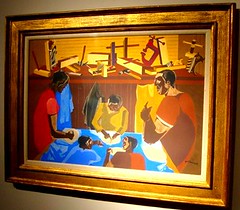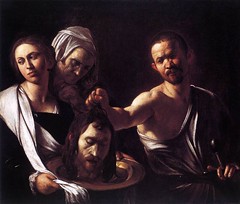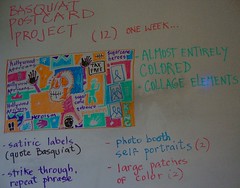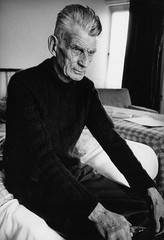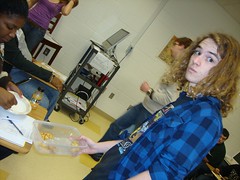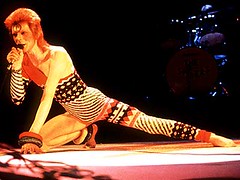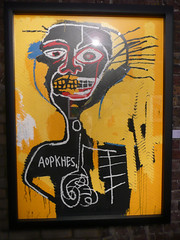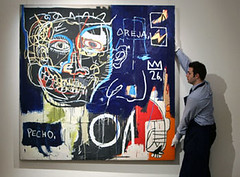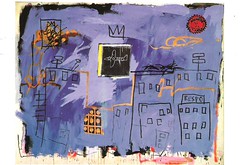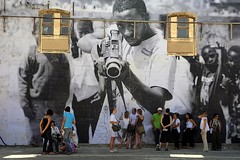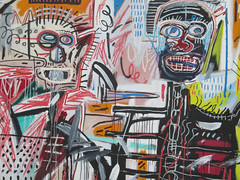Fine Arts review after Basquiat
1. Avant garde Irish novelist who wrote in a punctuation-less style called stream of consciousness: __ . a) Samuel Beckett b) James Joyce c) Jonathan Swift d) Oscar Wilde.
2. He wrote the existential, absurdist drama "Waiting for Godot." ___ . Use a choice as listed above.
3. "A Modest Proposal" offered the idea that the poor Irish might survive famine by having more babies - and eating them for sustenance. The author was __. Use a choice as listed above.
4. "Nothing that is worth knowing can be taught." That's from the witty playwright __.
Use a choice as listed above.
5. This artist's collages were thought to be better than his paintings: __.
a) Romare Bearden b) Julian Schnabel c) Jacob Lawrence d) Jean-Michel Basqiat.
6. This African-American painter often produced a stream of canvasses with a single theme, such as Migration: __ . Use a choice as listed above.
7. Broken ceramic dishes were glued to giant canvasses by this artist. He painted portraits atop the craggy field of crockery. __ . Use a choice as listed above.
8. Gray's Anatomy was one of his principal source books, or places where he got ideas and images for his paintings. __ . Use a choice as listed above.
9. Contemporary artist who has specialized in painting on velvet, on tarpaulins, on film, on sails and rug pads: __ . Use a choice as listed above.
10. His subject matter tended to be the civil rights movement and jazz: __ . Use a choice as listed above.
11. Had a Puerto Rican mother and Haitian father: __ . Use a choice as listed above.
12. "The Diving Bell and the Butterfly:" __ . Use a choice as listed above.
13. Caravaggio: a) 1200's b) 1400's c) 1600's d) 1800's.
14. Caravaggio's most dramatic schtick: a) satire b) street life c) fresco d) chiaroscuro.
15. The pre-emptive strike: a) Julius Caesar b) Cassius c) Brutus d) Cleopatra VII.
16. Basquiat was known for his a) movies b) embarrassing tirades c) work ethic d) his ability to adapt to the marketplace.
17. In the mid-1980's Basquiat collaborated on a series of paintings with the notable artist a) Jackson Pollock b) Langston Hughes c) Willem De Kooning d) Andy Warhol.
18. Basquiat'ss favorite part of Manhattan was the historic warehouse district which became a center for art and cool stuff, SoHo. It is adjacent to a) Columbia Univ b) Times Square c) Greenwich Village d) Harlem.
Wednesday, March 23, 2011
Jacob Lawrence: Harlem to Seattle
Jacob Lawrence (1917 - 2000) is among the best-known twentieth century African American painters, a distinction shared with Romare Bearden, says Wikipedia.
After dropping out of school at sixteen, Lawrence worked in a laundry and a printing plant. More importantly, he attended classes at the Harlem Art Workshop and had a paid position with the Works Progress Administration. He was able to study and work with notable Harlem Renaissance artists.
Lawrence was only in his twenties when his "Migration Series" made him nationally famous. A part of this series was featured in a 1941 issue of Fortune magazine. The series depicted the epic Great Migration of African Americans from the rural South to the urban North.
Throughout his lengthy artistic career, Lawrence concentrated on depicting the history and struggles of African Americans. Lawrence's work often portrayed important periods in African-American history.
In the 1970's he became an art prof at the Univ of Washington, Seattle.
After dropping out of school at sixteen, Lawrence worked in a laundry and a printing plant. More importantly, he attended classes at the Harlem Art Workshop and had a paid position with the Works Progress Administration. He was able to study and work with notable Harlem Renaissance artists.
Lawrence was only in his twenties when his "Migration Series" made him nationally famous. A part of this series was featured in a 1941 issue of Fortune magazine. The series depicted the epic Great Migration of African Americans from the rural South to the urban North.
Throughout his lengthy artistic career, Lawrence concentrated on depicting the history and struggles of African Americans. Lawrence's work often portrayed important periods in African-American history.
In the 1970's he became an art prof at the Univ of Washington, Seattle.
Tuesday, March 22, 2011
Caravaggio: Salome Receives the Head of Saint John I (1607)
Michelangelo Merisi da Caravaggio (29 September 1571 – 18 July 1610) was an Italian artist active in Rome, Naples, Malta, and Sicily between 1593 and 1610, says Wikipedia.
His paintings, which combine a realistic observation of the human state, both physical and emotional, with a dramatic use of lighting, had a formative influence on the Baroque school of painting. Among others, he influenced Rembrandt.
Caravaggio's style was a radical naturalism which combined close physical observation with a dramatic, even theatrical, use of chiaroscuro. He painted the shift from light to dark with little intermediate value.
He burst upon the Rome art scene in 1600 with the success of his first public commissions, the Martyrdom of Saint Matthew and Calling of Saint Matthew. Thereafter he never lacked for commissions or patrons, yet he handled his success badly, being caught in several felonious assaults.
The Cardsharps is perhaps Caravaggio's first true masterpiece.
Already evident was the intense realism or naturalism for which Caravaggio is now famous. He preferred to paint his subjects as the eye sees them, with all their natural flaws and defects instead of as idealised creations. This allowed a full display of Caravaggio's virtuosic talents. This shift from accepted standard practice and the classical idealism of Michelangelo was very controversial at the time. Not only was his realism a noteworthy feature of his paintings during this period, he turned away from the lengthy preparations traditional in central Italy at the time. Instead, he preferred the Venetian practice of working in oils directly from the subject - half-length figures and still life.
In 1599, presumably through the influence of Cardinal Del Monte, Caravaggio was contracted to decorate the Contarelli Chapel. The two works making up the commission, the Martyrdom of Saint Matthew and Calling of Saint Matthew, delivered in 1600, were an immediate sensation.
Major works from his Malta (Mediterranean island south of Sicily) period include a huge Beheading of Saint John the Baptist (the only painting to which he put his signature) and a Portrait of Alof de Wignacourt and his Page, as well as portraits of other leading knights.
He painted also a David with the Head of Goliath, showing the young David with a strangely sorrowful expression gazing on the severed head of the giant, which is Caravaggio's.
His paintings, which combine a realistic observation of the human state, both physical and emotional, with a dramatic use of lighting, had a formative influence on the Baroque school of painting. Among others, he influenced Rembrandt.
Caravaggio's style was a radical naturalism which combined close physical observation with a dramatic, even theatrical, use of chiaroscuro. He painted the shift from light to dark with little intermediate value.
He burst upon the Rome art scene in 1600 with the success of his first public commissions, the Martyrdom of Saint Matthew and Calling of Saint Matthew. Thereafter he never lacked for commissions or patrons, yet he handled his success badly, being caught in several felonious assaults.
The Cardsharps is perhaps Caravaggio's first true masterpiece.
Already evident was the intense realism or naturalism for which Caravaggio is now famous. He preferred to paint his subjects as the eye sees them, with all their natural flaws and defects instead of as idealised creations. This allowed a full display of Caravaggio's virtuosic talents. This shift from accepted standard practice and the classical idealism of Michelangelo was very controversial at the time. Not only was his realism a noteworthy feature of his paintings during this period, he turned away from the lengthy preparations traditional in central Italy at the time. Instead, he preferred the Venetian practice of working in oils directly from the subject - half-length figures and still life.
In 1599, presumably through the influence of Cardinal Del Monte, Caravaggio was contracted to decorate the Contarelli Chapel. The two works making up the commission, the Martyrdom of Saint Matthew and Calling of Saint Matthew, delivered in 1600, were an immediate sensation.
Major works from his Malta (Mediterranean island south of Sicily) period include a huge Beheading of Saint John the Baptist (the only painting to which he put his signature) and a Portrait of Alof de Wignacourt and his Page, as well as portraits of other leading knights.
He painted also a David with the Head of Goliath, showing the young David with a strangely sorrowful expression gazing on the severed head of the giant, which is Caravaggio's.
Friday, March 18, 2011
Magnet fine arts Basquiat postcard project
Due Wed, Mar 23.
12 pts.
Alternative:
brief essay on the school drama production. Be detailed!
12 pts.
Alternative:
brief essay on the school drama production. Be detailed!
Thursday, March 17, 2011
Author of the absurdist play Waiting for Godot: Samuel Beckett
On St Patrick's Day, fine arts class looked at Irish artists.
Among them:
Samuel Beckett, the Irish avant-garde writer, dramatist and poet, writing in English and French. Beckett's work offers a bleak outlook on human culture and both formally and philosophically became increasingly minimalist in his later career.
See his Waiting for Godot, a disheartening if witty statement of the human condition.
Oscar Wilde, 1890's playwright, dandy and wit. "The Importance of Being Earnest. "Picture of Dorian Gray."
"Always forgive your enemies; nothing annoys them so much."
"I don't want to go to heaven. None of my friends are there."
"I am not young enough to know everything."
"Education is an admirable thing, but it is well to remember from time to time that nothing that is worth knowing can be taught."
Jonathan Swift, satirist of the 1700's. Most famous for the cannibal-minded A Modest Proposal.
Jame Joyce, the avant garde writer whose stream of consciousness novels were awesomelt influential in 20th century lit.
Ulysses, a version of The Odyssey, 1922.
Celtic design! Gaelic language. Nearly everyone from North Louisiana has Celtic roots.
We listened to Irish folk music-influenced -
Mumford & Sons
The Corrs
U2
On the map -
Eire
Dublin (Guinness beer and Book of World Records)
Northern Ireland (part of the UK)
Belfast and the HMS Titanic.
Scotland, England and Wales.
The Irish Sea.
Among them:
Samuel Beckett, the Irish avant-garde writer, dramatist and poet, writing in English and French. Beckett's work offers a bleak outlook on human culture and both formally and philosophically became increasingly minimalist in his later career.
See his Waiting for Godot, a disheartening if witty statement of the human condition.
Oscar Wilde, 1890's playwright, dandy and wit. "The Importance of Being Earnest. "Picture of Dorian Gray."
"Always forgive your enemies; nothing annoys them so much."
"I don't want to go to heaven. None of my friends are there."
"I am not young enough to know everything."
"Education is an admirable thing, but it is well to remember from time to time that nothing that is worth knowing can be taught."
Jonathan Swift, satirist of the 1700's. Most famous for the cannibal-minded A Modest Proposal.
Jame Joyce, the avant garde writer whose stream of consciousness novels were awesomelt influential in 20th century lit.
Ulysses, a version of The Odyssey, 1922.
Celtic design! Gaelic language. Nearly everyone from North Louisiana has Celtic roots.
We listened to Irish folk music-influenced -
Mumford & Sons
The Corrs
U2
On the map -
Eire
Dublin (Guinness beer and Book of World Records)
Northern Ireland (part of the UK)
Belfast and the HMS Titanic.
Scotland, England and Wales.
The Irish Sea.
Tuesday, March 15, 2011
Julian Schnabel's portrait of Andy Warhol - oil paint on velvet
Julian Schnabel (born October 26, 1951) is an American artist and filmmaker. In the 1980s Schnabel received international media attention for his "plate paintings"—large-scale paintings set on broken ceramic plates.
Schnabel directed Before Night Falls, which became Javier Bardem's breakthrough Academy Award nominated role and The Diving Bell and the Butterfly, which was nominated for four Academy Awards.
He has won a Golden Globe, as well as BAFTA, a César Award, a Golden Palm, two nominations for the Golden Lion and an Academy Award nomination.
His paintings have been executed on the heroic scale for some time. He has also won attention for painting on tarpaulins, sails and other unexpected fabrics.
Schnabel lives in New York, maintaining studios in New York City and in Montauk on the eastern end of Long Island with a house in San Sebastian in Spain.[3] He has three children by his first wife, clothing designer Jacqueline Beaurang: two daughters, Lola, a painter and film-maker, Stella, a poet and actress, and a son, Vito, an art dealer.[10]
He also has twin sons, Cy and Olmo, by his second wife, Spanish Basque actress and model Olatz López Garmendia. Garmendia appeared in Before Night Falls, and is also to be seen in The Diving Bell, as Bauby's physical therapist.[3] Schnabel is fluent in Spanish.[citation needed] He also learned French to direct The Diving Bell and the Butterfly.
Schnabel is currently in a relationship with Rula Jebreal.[11] Jebreal penned the screenplay, and original source novel, for Schnabel's film Miral.
His NYC home is at 360 West 11th Street. It is a former West Village horse stable that Schnabel purchased and converted for residential use, adding five luxury condominiums in the style of a Northern Italian palazzo. It is named the Palazzo Chupi and it's easy to spot because it is painted pink.[12]
Filmography
* Basquiat (1996)
* Before Night Falls (2000)
* The Diving Bell and the Butterfly (2007)
* Lou Reed's Berlin (2007)
* Miral (2010)
Schnabel directed Before Night Falls, which became Javier Bardem's breakthrough Academy Award nominated role and The Diving Bell and the Butterfly, which was nominated for four Academy Awards.
He has won a Golden Globe, as well as BAFTA, a César Award, a Golden Palm, two nominations for the Golden Lion and an Academy Award nomination.
His paintings have been executed on the heroic scale for some time. He has also won attention for painting on tarpaulins, sails and other unexpected fabrics.
Schnabel lives in New York, maintaining studios in New York City and in Montauk on the eastern end of Long Island with a house in San Sebastian in Spain.[3] He has three children by his first wife, clothing designer Jacqueline Beaurang: two daughters, Lola, a painter and film-maker, Stella, a poet and actress, and a son, Vito, an art dealer.[10]
He also has twin sons, Cy and Olmo, by his second wife, Spanish Basque actress and model Olatz López Garmendia. Garmendia appeared in Before Night Falls, and is also to be seen in The Diving Bell, as Bauby's physical therapist.[3] Schnabel is fluent in Spanish.[citation needed] He also learned French to direct The Diving Bell and the Butterfly.
Schnabel is currently in a relationship with Rula Jebreal.[11] Jebreal penned the screenplay, and original source novel, for Schnabel's film Miral.
His NYC home is at 360 West 11th Street. It is a former West Village horse stable that Schnabel purchased and converted for residential use, adding five luxury condominiums in the style of a Northern Italian palazzo. It is named the Palazzo Chupi and it's easy to spot because it is painted pink.[12]
Filmography
* Basquiat (1996)
* Before Night Falls (2000)
* The Diving Bell and the Butterfly (2007)
* Lou Reed's Berlin (2007)
* Miral (2010)
Romare Bearden: painting, collages and the Black experience
Romare Bearden (1911 – 1988) was an African American artist and writer. He worked in several media including cartoons, oils, and collage.
Bearden was born in Mecklenburg County, North Carolina. His family moved him to New York City as a toddler, and their household soon became a meeting place for major figures of the Harlem Renaissance.[1] In 1929 he graduated from Peabody High School in Pittsburgh, Pennsylvania. He completed his studies at New York University (NYU), graduating with a degree in science and education in 1935.
In the late 1950s, Bearden's work became more abstract, using layers of oil paint to produce muted, hidden effects. In 1956, Bearden began studying with a Chinese calligrapher, whom he credits with introducing him to new ideas about space and composition in painting. He also spent a lot of time studying famous European paintings he admired, particularly the work of the Dutch artists Johannes Vermeer, Pieter de Hooch, and Rembrandt.
During the 1960s civil rights movement, Bearden started to experiment again, this time with forms of collage (Brenner Hinish and Moore, 2003). After helping to found an artist's group in support of civil rights, Bearden's work became more representational and more overtly socially conscious.
He used clippings from magazines, which in and of itself was a new medium as glossy magazines were fairly new. He used these glossy scraps to incorporate modernity in his works, trying to show how not only were African American rights moving forward, but so was his socially conscious art.
In 1964, he held an exhibition he called Projections, where he introduced his new collage style. These works were very well received, and these are generally considered to be his best work (Fine, 2004).
Bearden was born in Mecklenburg County, North Carolina. His family moved him to New York City as a toddler, and their household soon became a meeting place for major figures of the Harlem Renaissance.[1] In 1929 he graduated from Peabody High School in Pittsburgh, Pennsylvania. He completed his studies at New York University (NYU), graduating with a degree in science and education in 1935.
In the late 1950s, Bearden's work became more abstract, using layers of oil paint to produce muted, hidden effects. In 1956, Bearden began studying with a Chinese calligrapher, whom he credits with introducing him to new ideas about space and composition in painting. He also spent a lot of time studying famous European paintings he admired, particularly the work of the Dutch artists Johannes Vermeer, Pieter de Hooch, and Rembrandt.
During the 1960s civil rights movement, Bearden started to experiment again, this time with forms of collage (Brenner Hinish and Moore, 2003). After helping to found an artist's group in support of civil rights, Bearden's work became more representational and more overtly socially conscious.
He used clippings from magazines, which in and of itself was a new medium as glossy magazines were fairly new. He used these glossy scraps to incorporate modernity in his works, trying to show how not only were African American rights moving forward, but so was his socially conscious art.
In 1964, he held an exhibition he called Projections, where he introduced his new collage style. These works were very well received, and these are generally considered to be his best work (Fine, 2004).
Julius Caesar and Cassius: the pre-emptive strike
The pre-emptive strike and the Ides of March.
The assassination of Julius Caesar was the result of a conspiracy by approximately forty Roman senators, says Wikipedia.
Led by Gaius Cassius Longinus and Marcus Junius Brutus, they stabbed Julius Caesar to death in the Theatre of Pompey on the Ides of March (March 15) 44 BC.
Caesar was the dictator of the Roman Republic at the time, having recently been declared dictator perpetuo by the Senate. This declaration made several senators fear that Caesar wanted to overthrow the Senate in favour of tyranny.
In the US, the Bush administration first claimed the right to declare a preemptive war (see Bush Doctrine) after 2001.[27] This American claim was soon followed up with the American invasion of Iraq in the Iraq War for the purpose of preventing Iraq from developing nuclear, chemical, and biological warfare technologies.[28]
The assassination of Julius Caesar was the result of a conspiracy by approximately forty Roman senators, says Wikipedia.
Led by Gaius Cassius Longinus and Marcus Junius Brutus, they stabbed Julius Caesar to death in the Theatre of Pompey on the Ides of March (March 15) 44 BC.
Caesar was the dictator of the Roman Republic at the time, having recently been declared dictator perpetuo by the Senate. This declaration made several senators fear that Caesar wanted to overthrow the Senate in favour of tyranny.
In the US, the Bush administration first claimed the right to declare a preemptive war (see Bush Doctrine) after 2001.[27] This American claim was soon followed up with the American invasion of Iraq in the Iraq War for the purpose of preventing Iraq from developing nuclear, chemical, and biological warfare technologies.[28]
Space oddities cross paths on a shiny plane: Basquiat and David Bowie
The Artist and the Oddity
Jacob Flett
Throughout history, the world has seen many eccentric artists. Vincent van Gogh, a social outcast, saw the world in a different way than most people, and expressed his vision through his art. Pablo Picasso painted in an abstract way that was revolutionary compared to what people were used to in fine art. Andy Warhol took the definition of fine art and turned it upside down. Jackson Pollack urinated in public.
Two of these eccentric artists are very good examples of this. Jean-Michel Basquiat, a former graffiti artist living on the streets, who became a famous artist through what was basically metaphorical doodles. David Bowie, a famous rock star, who revolutionized the world
of music with his odd musical style and over-the-top style of dress. For a brief period of time, both of these men actually worked together. However, there are many other things these two artists have in common with each other.
For example, both these men, at some point in their career, were musicians. Bowie, obviously, was famous for being a musician, as the main point of his career was the music he made. Basquiat, though not famous for it, also made music with his noise-rock band, Gray. Gray
preformed in nightclubs such as Max’s Kansas City, CBGB, Hurra, and the Mudd Club. However, while Gray had a rather small and short lived career, David Bowie’s musical career has been incredibly huge and enormously influential, and he has remained active since the 60’s. Both
artists have also starred in film as well. Bowie’s acting career was the much larger of the two, with Basquiat only starring in the independent film Downtown 81. David Bowie, however, has played in many films, one of them being the cult classic fantasy Labrinth, in which he plays
Jareth, the evil goblin king. This film was well known for featuring the music of David Bowie, which made it a sort of off-hand musical. Bowie also played Andy Warhol in the film Basquiat, a biopic of the life of Jean-Michel Basquiat.
Both of these men had a specific art form that made them famous though: Basquiat through his painting and David Bowie through his musical career. Both of their art forms were seen as off-the-wall, whether it was Basquiat’s graffiti inspired doodling, or Bowie’s over the
top stage rock. Basquiat’s colorful and seemingly random style of painting could easily be compared to David Bowie’s colorful (and seeming random) approach to his own art. Both artists
took influence from their predecessors, yet took the concepts they used to new and ever-expanding heights.
Jacob Flett
Throughout history, the world has seen many eccentric artists. Vincent van Gogh, a social outcast, saw the world in a different way than most people, and expressed his vision through his art. Pablo Picasso painted in an abstract way that was revolutionary compared to what people were used to in fine art. Andy Warhol took the definition of fine art and turned it upside down. Jackson Pollack urinated in public.
Two of these eccentric artists are very good examples of this. Jean-Michel Basquiat, a former graffiti artist living on the streets, who became a famous artist through what was basically metaphorical doodles. David Bowie, a famous rock star, who revolutionized the world
of music with his odd musical style and over-the-top style of dress. For a brief period of time, both of these men actually worked together. However, there are many other things these two artists have in common with each other.
For example, both these men, at some point in their career, were musicians. Bowie, obviously, was famous for being a musician, as the main point of his career was the music he made. Basquiat, though not famous for it, also made music with his noise-rock band, Gray. Gray
preformed in nightclubs such as Max’s Kansas City, CBGB, Hurra, and the Mudd Club. However, while Gray had a rather small and short lived career, David Bowie’s musical career has been incredibly huge and enormously influential, and he has remained active since the 60’s. Both
artists have also starred in film as well. Bowie’s acting career was the much larger of the two, with Basquiat only starring in the independent film Downtown 81. David Bowie, however, has played in many films, one of them being the cult classic fantasy Labrinth, in which he plays
Jareth, the evil goblin king. This film was well known for featuring the music of David Bowie, which made it a sort of off-hand musical. Bowie also played Andy Warhol in the film Basquiat, a biopic of the life of Jean-Michel Basquiat.
Both of these men had a specific art form that made them famous though: Basquiat through his painting and David Bowie through his musical career. Both of their art forms were seen as off-the-wall, whether it was Basquiat’s graffiti inspired doodling, or Bowie’s over the
top stage rock. Basquiat’s colorful and seemingly random style of painting could easily be compared to David Bowie’s colorful (and seeming random) approach to his own art. Both artists
took influence from their predecessors, yet took the concepts they used to new and ever-expanding heights.
Monday, March 14, 2011
Madonna, Bowie, Schnabel, Warhol, Basquiat
Create a comparison piece on the bio of Basquiat and bio of one of these figures
- Madonna
- David Bowie
- Warhol
- Julian Schnabel
Either
1) a comparison essay - heavy on quoted facts. Please avoid opinion.
or
2) Visual comparison. Notes atop 6 images.
- Madonna
- David Bowie
- Warhol
- Julian Schnabel
Either
1) a comparison essay - heavy on quoted facts. Please avoid opinion.
or
2) Visual comparison. Notes atop 6 images.
Basquiat postcard project / due in one week; 12 pts
Post cards were the best of Basquiat's early merch efforts. In a famous moment in his early, wannabe days, he sold a couple of postcards to Warhol.
Our postcard will have 2 goals:
1. To send to someone who will be delighted to get a piece of mail art.
2. To memorialize the elements of Basquiat's work so we can remember them and use them later.
- Use B's words, colors, designs, and style.
- Almost entirely colored. Bold, primary colors.
- Collage 2 small photos of yourself as in the photobooth images used by both B and Warhol.
- Quote his satiric phrases and words. He is, after all, a poet.
- Strike through some of what you print in repeated format.
- Include the crown motif. Additional motifs: skulls, heads, hands.
12 pts.
Digital version:
- Assemble at least 6 panels into a synthetic Basquiat composition.
Our postcard will have 2 goals:
1. To send to someone who will be delighted to get a piece of mail art.
2. To memorialize the elements of Basquiat's work so we can remember them and use them later.
- Use B's words, colors, designs, and style.
- Almost entirely colored. Bold, primary colors.
- Collage 2 small photos of yourself as in the photobooth images used by both B and Warhol.
- Quote his satiric phrases and words. He is, after all, a poet.
- Strike through some of what you print in repeated format.
- Include the crown motif. Additional motifs: skulls, heads, hands.
12 pts.
Digital version:
- Assemble at least 6 panels into a synthetic Basquiat composition.
Movie and bio quiz on Basquiat: the Radiant Child
Basquiat quiz / Trudeau
1. In Langston Hughes' poem, "Genius Child," what is the solution to the problem presented by a child who is far smarter and more creative than the average?
a) murder him b) set him free c) make sure he can roam in natural surroundings d) shower him with love.
2. Infamous: a) famous within a specific realm b) not famous at all c) famous for being famous d) famous for bad deeds.
3. Basquiat grew up in Brooklyn in a family that was a) middle class
b) working class c) impoverished d) wealthy.
4. The movie opens with Dizzy Gillespie's "Salt peanuts." Gillespie would be an example of Basquiat's favorite musical style: a) cool jazz b) street jazz a la New Orleans c) jazz rock d) bebop.
5. Basquiat's first artistic persona was a) Peso b) Spamo c) Samo d) Warho.
6. His paintings were marked by crude image-making. a) Yet he could draw well. b) Because he was not strong in drawing. c) He was a child of TV and video.
7. His springboard to fame seems to have been a positive critique by a) ArtForum magazine b) Life magazine c) CBS News d) Andy Warhol.
8. Basquiat was known for his a) movies b) embarrassing tirades c) work ethic d) his ability to adapt to the marketplace.
9. His most-favored retreat: a) Switzerland b) France c) Hawaii d) Haiti.
10. In the mid-1980's Basquiat collaborated on a series of paintings with the notable artist a) Jackson Pollock b) Langston Hughes c) Willem De Kooning d) Andy Warhol.
11. In his paintings Basquiat typically ignored his African-Haitian background. T / F
12. His favored sources for painting ideas included a) Shakespearean plays b) newspaper comics c) Physician's Desk Reference d) Gray's Anatomy.
13. His favorite part of Manhattan was the historic warehouse district which became a center for art and cool stuff, SoHo, which is adjacent to a) Columbia Univ b) Times Square c) Greenwich Village d) Harlem.
1. In Langston Hughes' poem, "Genius Child," what is the solution to the problem presented by a child who is far smarter and more creative than the average?
a) murder him b) set him free c) make sure he can roam in natural surroundings d) shower him with love.
2. Infamous: a) famous within a specific realm b) not famous at all c) famous for being famous d) famous for bad deeds.
3. Basquiat grew up in Brooklyn in a family that was a) middle class
b) working class c) impoverished d) wealthy.
4. The movie opens with Dizzy Gillespie's "Salt peanuts." Gillespie would be an example of Basquiat's favorite musical style: a) cool jazz b) street jazz a la New Orleans c) jazz rock d) bebop.
5. Basquiat's first artistic persona was a) Peso b) Spamo c) Samo d) Warho.
6. His paintings were marked by crude image-making. a) Yet he could draw well. b) Because he was not strong in drawing. c) He was a child of TV and video.
7. His springboard to fame seems to have been a positive critique by a) ArtForum magazine b) Life magazine c) CBS News d) Andy Warhol.
8. Basquiat was known for his a) movies b) embarrassing tirades c) work ethic d) his ability to adapt to the marketplace.
9. His most-favored retreat: a) Switzerland b) France c) Hawaii d) Haiti.
10. In the mid-1980's Basquiat collaborated on a series of paintings with the notable artist a) Jackson Pollock b) Langston Hughes c) Willem De Kooning d) Andy Warhol.
11. In his paintings Basquiat typically ignored his African-Haitian background. T / F
12. His favored sources for painting ideas included a) Shakespearean plays b) newspaper comics c) Physician's Desk Reference d) Gray's Anatomy.
13. His favorite part of Manhattan was the historic warehouse district which became a center for art and cool stuff, SoHo, which is adjacent to a) Columbia Univ b) Times Square c) Greenwich Village d) Harlem.
Thursday, March 10, 2011
Notes on movie "Jean-Michel Basquiat: Radiant Child"
Langston Hughes
Genius child
This is a song for the genius child.
Sing it softly, for the song is wild.
Sing it softly as ever you can -
Lest the song get out of hand.
Nobody loves a genius child.
Can you love an eagle,
Tame or wild?
Can you love an eagle,
Wild or tame?
Can you love a monster
Of frightening name?
Nobody loves a genius child.
Kill him - and let his soul run wild.
Jean-Michel Basquiat: The Radiant Child by Tamra Davis
- famous for being famous, for being infamous
Brooklyn, 1960 - 1988
born to Puerto Rican mother and Haitian father.
Tri-lingual child; precocious.
Taken to museums as child; art encouraged.
Father was successful accountant, middle class.
"Salt peanuts," bebop tune by Dizzy Gillespie, 1940's.
Late 1970's NYC
- crime-ridden
- Manhattan affordable
- graffiti being born
- movies "Taxi Driver," "Midnight Cowboy"
- SoHo / Canal St / the Bowery
- art crowd: "downtown 500"
- panhandling
- J-MB: oblique poetry
- SAMO: multiple-choice graffiti, ideas
- J-MB and friends began noise band "Grey"
- J-MB begins to make t-shirts, collages and collage postcards
- sells postcards to the God of NYC art, Andy Warhol
- Mudd Club, CBGBs
- Fab 5 Freddy: graffiti, hip hop artist, MTV host, producer
- J-MB as teen had a clear, strong hand in sketching
- star of indie movie "Downtown 81"
- cannot hold a straight job
- The Times Square Show, 100 artists, including J-MB
- artists Keith Haring, Kenny Scharf
- using street refuse instead of canvas - paintings on doors, windows, tires, sheets of paper, on floor
- loved books as source material; Grey's Anatomy, Mark Twain.
- emerges with NY New Wave Show at PS 1, 1981, curator Diego Cortez.
- given studio space in Annina Nosei's gallery, SoHo.
- "Bolero," by Maurice Ravel
- made $200,000 in Annina Nosei show
- ArtForum profile a springboard to fame.
- "street energy into high art"
- paintings have numerous references to art history
- Loved literature from Mark Twain to radical writer William Burroughs (collage/cut-up writing from surrealists)
- Jazz lover: Bird, Trane, Miles, bebop
- in effect, a bebop painter
- "incredible work ethic," "constantly painting"
- ambitious, competitive
- Larry Gagosian Gallery, Los Angeles, 1983
- charisma
- Swiss art dealer, Bruno Bischofberger, who was associated with Warhol, etc
- exhibits alongside top artists such as Julian Schnabel, who eventually made a bio film, "Basquiat."
- making huge amounts of money; no bank account
- gourmet delights; constant party at his studio.
- NY Times magazine cover story: "New Art, New Money: The Marketing of an American Artist"
- hanging w celebs: affair w/ Madonna in '82.
- Warhol does J-MB portrait
- Warhol: "I am so jealous; he's faster than me."
- art world cognoscenti did not fully accept him as great artist
- minimalism, conceptualism had been regnant in 70's NYC
- category for J-MB: neo-expressionist
- on painting: "constant editing process"
- "I cross out words so that you will see them more."
- hit by car at age 7; spleen removed. Given copy of Grey's Anatomy.
- child-like view and style.
- Venice (LA) studio - away from celebritydom of NYC.
- Pressure of stardom: began to use heroin.
- Romance of artist whose life is so intense it is impossible to bear.
- Affected by the beating death of Michael Stewart by NYC cops.
- "The black Picasso."
- Looked to some people as primitive artist.
- "Excavated black history of Black Americans."
- "This year's interesting negro."
- People exploiting him.
- Substance abuse.
- Hana, Hawaii, as retreat. No drugs.
- Warhol a father figure.
- Collaboration with Warhol, 1984 - 86.
- Warhol-Basquiat show: bad reviews.
- Warhol death, 1987. J-MB devastated.
- "They tell me the drugs are killing me. And I stop. Then they tell me my art is dead."
- Final paintings were stark. Age of 27. "Riding with death."
- Difficulty with father, with the press, with emotions, with drugs.
- Most famous artist of his generation.
- Afraid of drugs, becomes isolated; afraid his career was over.
- Body of work: 1000 paintings, 1000 drawings.
- More appreciated today than during his life.
Genius child
This is a song for the genius child.
Sing it softly, for the song is wild.
Sing it softly as ever you can -
Lest the song get out of hand.
Nobody loves a genius child.
Can you love an eagle,
Tame or wild?
Can you love an eagle,
Wild or tame?
Can you love a monster
Of frightening name?
Nobody loves a genius child.
Kill him - and let his soul run wild.
Jean-Michel Basquiat: The Radiant Child by Tamra Davis
- famous for being famous, for being infamous
Brooklyn, 1960 - 1988
born to Puerto Rican mother and Haitian father.
Tri-lingual child; precocious.
Taken to museums as child; art encouraged.
Father was successful accountant, middle class.
"Salt peanuts," bebop tune by Dizzy Gillespie, 1940's.
Late 1970's NYC
- crime-ridden
- Manhattan affordable
- graffiti being born
- movies "Taxi Driver," "Midnight Cowboy"
- SoHo / Canal St / the Bowery
- art crowd: "downtown 500"
- panhandling
- J-MB: oblique poetry
- SAMO: multiple-choice graffiti, ideas
- J-MB and friends began noise band "Grey"
- J-MB begins to make t-shirts, collages and collage postcards
- sells postcards to the God of NYC art, Andy Warhol
- Mudd Club, CBGBs
- Fab 5 Freddy: graffiti, hip hop artist, MTV host, producer
- J-MB as teen had a clear, strong hand in sketching
- star of indie movie "Downtown 81"
- cannot hold a straight job
- The Times Square Show, 100 artists, including J-MB
- artists Keith Haring, Kenny Scharf
- using street refuse instead of canvas - paintings on doors, windows, tires, sheets of paper, on floor
- loved books as source material; Grey's Anatomy, Mark Twain.
- emerges with NY New Wave Show at PS 1, 1981, curator Diego Cortez.
- given studio space in Annina Nosei's gallery, SoHo.
- "Bolero," by Maurice Ravel
- made $200,000 in Annina Nosei show
- ArtForum profile a springboard to fame.
- "street energy into high art"
- paintings have numerous references to art history
- Loved literature from Mark Twain to radical writer William Burroughs (collage/cut-up writing from surrealists)
- Jazz lover: Bird, Trane, Miles, bebop
- in effect, a bebop painter
- "incredible work ethic," "constantly painting"
- ambitious, competitive
- Larry Gagosian Gallery, Los Angeles, 1983
- charisma
- Swiss art dealer, Bruno Bischofberger, who was associated with Warhol, etc
- exhibits alongside top artists such as Julian Schnabel, who eventually made a bio film, "Basquiat."
- making huge amounts of money; no bank account
- gourmet delights; constant party at his studio.
- NY Times magazine cover story: "New Art, New Money: The Marketing of an American Artist"
- hanging w celebs: affair w/ Madonna in '82.
- Warhol does J-MB portrait
- Warhol: "I am so jealous; he's faster than me."
- art world cognoscenti did not fully accept him as great artist
- minimalism, conceptualism had been regnant in 70's NYC
- category for J-MB: neo-expressionist
- on painting: "constant editing process"
- "I cross out words so that you will see them more."
- hit by car at age 7; spleen removed. Given copy of Grey's Anatomy.
- child-like view and style.
- Venice (LA) studio - away from celebritydom of NYC.
- Pressure of stardom: began to use heroin.
- Romance of artist whose life is so intense it is impossible to bear.
- Affected by the beating death of Michael Stewart by NYC cops.
- "The black Picasso."
- Looked to some people as primitive artist.
- "Excavated black history of Black Americans."
- "This year's interesting negro."
- People exploiting him.
- Substance abuse.
- Hana, Hawaii, as retreat. No drugs.
- Warhol a father figure.
- Collaboration with Warhol, 1984 - 86.
- Warhol-Basquiat show: bad reviews.
- Warhol death, 1987. J-MB devastated.
- "They tell me the drugs are killing me. And I stop. Then they tell me my art is dead."
- Final paintings were stark. Age of 27. "Riding with death."
- Difficulty with father, with the press, with emotions, with drugs.
- Most famous artist of his generation.
- Afraid of drugs, becomes isolated; afraid his career was over.
- Body of work: 1000 paintings, 1000 drawings.
- More appreciated today than during his life.
Tuesday, March 8, 2011
A global celebration: the roots of Carnival quiz
The Roots of Carnival quiz
1. New Orleans African heritage: a) West b) East c) North
2. translate: bons
3. translate: rouler
4. translate: laissez
5. translate: temps
6. translate: gras
7. Louisiana's carnival season does not begin on a) Twelfth Night b) Epiphany c) Jan 6 d) Ash Wed.
8. Dionysian celebration: a) Greek b) Roman c) Persian.
9. Lupercalia: a) Greek b) Roman c) Persian.
10. Translate a) Carne: ___ b) vale: ___
11. Translate: "Lent."
12. First 5 nations associated with carnival.
13. First historic era in which Carnevale is written about: a) Medieval b) Renaissance c) Elizabethan.
14. Examples (2) of riotous behavior.
15. Translate: Shrove Tuesday.
16. Female krewe in New Orleans.
17. Why were parades instututed in New Orleans about 1857?
18. Two European cities that estabish the early carnival customs.
19. First krewe of Louisiana.
20. Alabama location with considerable influence on New Orleans (NO) Carnival?
21. 2 differences between Alabama and NO celebrations.
22. Primary public activity that was considered a basic pleasure of the pioneer days?
23. The location of Congo Square in New Orleans?
24. Activities by slaves in Congo Square? Frequency?
25. The second oldest krewe?
26. 3 customs established by Rex.
27. Etymology of “Rex.”
28. Make a timeline of Comus, Rex and Zulu.
29. Cheap coin “throw”?
30. Mardi Gras has neighborhood clubs that call themselves "gangs."
Are they a) MG Indians b) Drug organizations c) Brass bands.
31. What organization is brought to mind by the phrase “two-way pocky way!”?
32. Blanc et Noir Marching Society will hire what sort of band for the Krewe of Highland parade?
33. When did jazz music begin?
34. In what kinds of bands did jazz begin?
35. Explain the meaning of the French term "boeuf gras."
36. What are the flambeaux?
37. A famous Louisianian signed his letters, “Red beans and ricely yours,” His name and nickname?
38. What is one of the themes of New Orleans costuming?
39. How long did French immigrants live in Nova Scotia before a journey that would take them to Louisiana?
40. Why are they called Acadians, or Cajuns?
41. What is the name for the Cajun Mardi Gras?
42. Another name for a Cajun house party?
43. What 2 types of music mingle in Zydeco?
44. What ethnic group created zydeco?
45. Make a small map featuring Europe, South America, Central America and North America. List nations in which we see a significant carnival celebration.
answers -
1. W Af: Senegal, Guinea, Liberia, etc etc
2. bons - good
3. rouler - to roll
4. laissez - to let
5. temps - times
6. gras - fat
7. 12th Night begins Carnival in La. aka Epiphany or Jan 6.
8. Dionysian - Greek revels
9. Lupercalia - Roman rituals
10. carne - meat / vale - goodbye Latin
11. Lent - Christian; 40 days fasting & abstinence
12. Original Carnival nations: Italy, Germany, France, Spain, Portugal.
13. Medieval times: first mention of Carnival.
14. Riotous: throwing bricks, desecrating churches.
15. Shrive: forgive your sins. See English custom.
16. Endymion is a female krewe in NO.
17. Parades helped the city move away from Fat Tuesday anarchy.
18. Carnival origins: Venice, Rome.
19. 1st NO krewe: Mystick Krewe of Comus.
20. Mobile, AL
21. Alabama: New Years celebration / Cowbellian de rakin Society
NO: Fat Tuesday / Comus
22. Pioneers: dancing!
23. Congo Square: back of the city of NO.
24. Congo Square: dancing, singing every Sunday.
25. 2nd oldest: Rex.
26. Rex: doubloons, colors purple, green, gold, a holiday from school.
27. Rex: "king" Latin
28. a) Comus b) Rex c) Zulu
29. doubloon
30. MG Indians
31. MG Indians: "two way pocky way"
32. jazz
33. jazz originates in 1890's.
34. Jazz originates in brass bands.
35. Boeuf gras: Fat beef cow.
36. flambeaux: torches.
37. Louis Satchmo Armstrong: "Red beans ..."
38. Costuming: opposite of who you are.
39. Acadiennes: 100 years in Nova Scotia.
40. Acadians - people from a region called Acadia.
41. Courir de Mardi Gras: cajuns.
42. bals de Maison: house party.
43. Zydeco: blues plus French folk music.
44. Creoles created both zydeco as well as Cajun music.
45. map.
1. New Orleans African heritage: a) West b) East c) North
2. translate: bons
3. translate: rouler
4. translate: laissez
5. translate: temps
6. translate: gras
7. Louisiana's carnival season does not begin on a) Twelfth Night b) Epiphany c) Jan 6 d) Ash Wed.
8. Dionysian celebration: a) Greek b) Roman c) Persian.
9. Lupercalia: a) Greek b) Roman c) Persian.
10. Translate a) Carne: ___ b) vale: ___
11. Translate: "Lent."
12. First 5 nations associated with carnival.
13. First historic era in which Carnevale is written about: a) Medieval b) Renaissance c) Elizabethan.
14. Examples (2) of riotous behavior.
15. Translate: Shrove Tuesday.
16. Female krewe in New Orleans.
17. Why were parades instututed in New Orleans about 1857?
18. Two European cities that estabish the early carnival customs.
19. First krewe of Louisiana.
20. Alabama location with considerable influence on New Orleans (NO) Carnival?
21. 2 differences between Alabama and NO celebrations.
22. Primary public activity that was considered a basic pleasure of the pioneer days?
23. The location of Congo Square in New Orleans?
24. Activities by slaves in Congo Square? Frequency?
25. The second oldest krewe?
26. 3 customs established by Rex.
27. Etymology of “Rex.”
28. Make a timeline of Comus, Rex and Zulu.
29. Cheap coin “throw”?
30. Mardi Gras has neighborhood clubs that call themselves "gangs."
Are they a) MG Indians b) Drug organizations c) Brass bands.
31. What organization is brought to mind by the phrase “two-way pocky way!”?
32. Blanc et Noir Marching Society will hire what sort of band for the Krewe of Highland parade?
33. When did jazz music begin?
34. In what kinds of bands did jazz begin?
35. Explain the meaning of the French term "boeuf gras."
36. What are the flambeaux?
37. A famous Louisianian signed his letters, “Red beans and ricely yours,” His name and nickname?
38. What is one of the themes of New Orleans costuming?
39. How long did French immigrants live in Nova Scotia before a journey that would take them to Louisiana?
40. Why are they called Acadians, or Cajuns?
41. What is the name for the Cajun Mardi Gras?
42. Another name for a Cajun house party?
43. What 2 types of music mingle in Zydeco?
44. What ethnic group created zydeco?
45. Make a small map featuring Europe, South America, Central America and North America. List nations in which we see a significant carnival celebration.
answers -
1. W Af: Senegal, Guinea, Liberia, etc etc
2. bons - good
3. rouler - to roll
4. laissez - to let
5. temps - times
6. gras - fat
7. 12th Night begins Carnival in La. aka Epiphany or Jan 6.
8. Dionysian - Greek revels
9. Lupercalia - Roman rituals
10. carne - meat / vale - goodbye Latin
11. Lent - Christian; 40 days fasting & abstinence
12. Original Carnival nations: Italy, Germany, France, Spain, Portugal.
13. Medieval times: first mention of Carnival.
14. Riotous: throwing bricks, desecrating churches.
15. Shrive: forgive your sins. See English custom.
16. Endymion is a female krewe in NO.
17. Parades helped the city move away from Fat Tuesday anarchy.
18. Carnival origins: Venice, Rome.
19. 1st NO krewe: Mystick Krewe of Comus.
20. Mobile, AL
21. Alabama: New Years celebration / Cowbellian de rakin Society
NO: Fat Tuesday / Comus
22. Pioneers: dancing!
23. Congo Square: back of the city of NO.
24. Congo Square: dancing, singing every Sunday.
25. 2nd oldest: Rex.
26. Rex: doubloons, colors purple, green, gold, a holiday from school.
27. Rex: "king" Latin
28. a) Comus b) Rex c) Zulu
29. doubloon
30. MG Indians
31. MG Indians: "two way pocky way"
32. jazz
33. jazz originates in 1890's.
34. Jazz originates in brass bands.
35. Boeuf gras: Fat beef cow.
36. flambeaux: torches.
37. Louis Satchmo Armstrong: "Red beans ..."
38. Costuming: opposite of who you are.
39. Acadiennes: 100 years in Nova Scotia.
40. Acadians - people from a region called Acadia.
41. Courir de Mardi Gras: cajuns.
42. bals de Maison: house party.
43. Zydeco: blues plus French folk music.
44. Creoles created both zydeco as well as Cajun music.
45. map.
Friday, March 4, 2011
The Warhol quiz
Andrew Warhola / Andy Warhol
1. Pittsburgh is on the a) west b) east c) north side of Pennsylvania.
2. Warhol attended ___ Institute, named for founder, philanthropist
and steel magnate Andrew __ . Same answer, both blanks.
3. Warhol was raised in a strongly __ ethnic community. a) Slovak
b) German c) Greek d) Turkish.
4. The word from recent vocab study that means "neither moral nor
immoral." _____ .
5. "Incomprehensible; mysterious or enigmatic:" a) mythical b)
susceptible c) vulnerable d) inscrutable.
6. Edie Sedgwick: a) drag queen b) journalist who criticized Warhol
c) wealthy socialite d) tried to murder Warhol.
7. Elizabeth Taylor, Marilyn Monroe and Jackie Kennedy were among the
famous faces in a photo/silk screen series called
a) Faces b) Icons c) Images d) Interviews.
8. Guns, knives, crosses: Warhol explained that his work was social
commentary. It was a view on the modern world of the 1960's. T / F
9. Chairman Mao was the Chinese leader who led the communist
revolution in the world's most populous nation. That revolution came
during the a) 1890's b) 1910's c) 1940's d) 1970's.
10. Before he became a success as a pop artist Warhol had a day job.
He was an a) ad writer b) shoe designer c) illustrator d) print
maker.
11. Arguably the most important woman in Warhol's life was __ .
12. In 1962 he sold the group of pop art silk-screen paintings for
$1000 to a Los Angeles gallery owner because they did not sell to art
collectors. They were images of __ .
13. The Fantastic Flying Books of Mr. Morris Lessmore was inspired by
William Joyce’s love for books, by hurricane Katrina, and by a classic
movie: __ __ __ .
14. The great art museum on 5th Avenue, NYC: a) Tate b) Corcoran c)
Met d) MoMa.
15. Warhol's most widely-known 1966 film (shown simultaneously on 2
projectors), The __ Girls, was filmed in - and named for - a lower
Manhattan hotel famous as a home to cool artistic and literary
characters.
16. Warhol's large art studio, a place for work and for the
shenanigans of tawdry hangers-on, was painted and papered in silver
and called The __ .
17. In 1964 the Pop Art master was commissioned by the World's Fair to
create a large piece for the NY Pavilion. It was rejected. The subject
matter was The Thirteen __ __ Men.
18. Warhol's portrait of a wealthy art collector, "Ethel Scull, 36
Times," was shot in a shocking location: a __ __ .
19. Critic Dave Hickey says that Warhol's work caused a major upheaval
in the way people looked at art, the graphic arts and product design.
That shift in point of view is called a __ __.
20. Adjacent to Connecticut is the NYC borough called __ .
21. The estimable NYC university that is adjacent to Harlem is __ .
22. According to the Ric Burns documentary Warhol enjoyed a steady
ingestion of the drug called __, though the amount was said to be
slight.
23. A silk screen image is created in part by coating a screen with a
light-sensitive goop called __ .
24. "In the future, everyone will be famous for __ minutes." How many minutes?
1. Pittsburgh is on the a) west b) east c) north side of Pennsylvania.
2. Warhol attended ___ Institute, named for founder, philanthropist
and steel magnate Andrew __ . Same answer, both blanks.
3. Warhol was raised in a strongly __ ethnic community. a) Slovak
b) German c) Greek d) Turkish.
4. The word from recent vocab study that means "neither moral nor
immoral." _____ .
5. "Incomprehensible; mysterious or enigmatic:" a) mythical b)
susceptible c) vulnerable d) inscrutable.
6. Edie Sedgwick: a) drag queen b) journalist who criticized Warhol
c) wealthy socialite d) tried to murder Warhol.
7. Elizabeth Taylor, Marilyn Monroe and Jackie Kennedy were among the
famous faces in a photo/silk screen series called
a) Faces b) Icons c) Images d) Interviews.
8. Guns, knives, crosses: Warhol explained that his work was social
commentary. It was a view on the modern world of the 1960's. T / F
9. Chairman Mao was the Chinese leader who led the communist
revolution in the world's most populous nation. That revolution came
during the a) 1890's b) 1910's c) 1940's d) 1970's.
10. Before he became a success as a pop artist Warhol had a day job.
He was an a) ad writer b) shoe designer c) illustrator d) print
maker.
11. Arguably the most important woman in Warhol's life was __ .
12. In 1962 he sold the group of pop art silk-screen paintings for
$1000 to a Los Angeles gallery owner because they did not sell to art
collectors. They were images of __ .
13. The Fantastic Flying Books of Mr. Morris Lessmore was inspired by
William Joyce’s love for books, by hurricane Katrina, and by a classic
movie: __ __ __ .
14. The great art museum on 5th Avenue, NYC: a) Tate b) Corcoran c)
Met d) MoMa.
15. Warhol's most widely-known 1966 film (shown simultaneously on 2
projectors), The __ Girls, was filmed in - and named for - a lower
Manhattan hotel famous as a home to cool artistic and literary
characters.
16. Warhol's large art studio, a place for work and for the
shenanigans of tawdry hangers-on, was painted and papered in silver
and called The __ .
17. In 1964 the Pop Art master was commissioned by the World's Fair to
create a large piece for the NY Pavilion. It was rejected. The subject
matter was The Thirteen __ __ Men.
18. Warhol's portrait of a wealthy art collector, "Ethel Scull, 36
Times," was shot in a shocking location: a __ __ .
19. Critic Dave Hickey says that Warhol's work caused a major upheaval
in the way people looked at art, the graphic arts and product design.
That shift in point of view is called a __ __.
20. Adjacent to Connecticut is the NYC borough called __ .
21. The estimable NYC university that is adjacent to Harlem is __ .
22. According to the Ric Burns documentary Warhol enjoyed a steady
ingestion of the drug called __, though the amount was said to be
slight.
23. A silk screen image is created in part by coating a screen with a
light-sensitive goop called __ .
24. "In the future, everyone will be famous for __ minutes." How many minutes?
The Pollock quiz
Jackson Pollock
1. Cheap housing can be had by struggling painters in the 1940's in Manhattan's __.
a) West Side b) Chelsea c) SoHo d) Lower East Side.
2. A perquisite, or "perk," for government work in the 1940's was a) draft deferment b) 4-F draft status c) salary adequate to feed a family d) free housing.
3. The state that is immediately northeast of New York: a) New Jersey b) Connecticut c) Delaware d) Massachusetts.
4. Pollock's almost-as-famous wife, also a modernist painter, was a) Peggy Guggenheim b) Marilyn Monroe c) Frida Kahlo d) Lee Krasner.
5. Pollock's principal patron was a) Peggy Guggenheim b) Marilyn Monroe c) Frida Kahlo d) Lee Krasner.
6. The school of art to which Pollock and his peers were attached by the media:
___ expressionism. a) Surrealist b) Abstract c) Modernist d) Dadaist.
7. American magazine with emphasis on photojournalism; it dominated the market from the 40's through the 70's: a) Fortune b) Look c) Life d) Saturday Evening Post.
8. American illustrator whose realistic work represented the values of the middle-class:
a) Norman Rockwell b) Thomas Hart Benton c) Marcel Duchamp d) Henry Luce.
9. T / F According to the movie Pollock the NY Times art critic wrote overwhelmingly positive reviews of his shows.
10. Pollock and Krasner have a productive period when they moved out of Manhattan. They relocated to a) Connecticut b) New Jersey c) Martha's Vineyard Island d) Long Island.
11. Successful artist of Pollock's circle a) Pablo Picasso b) Willem de Kooning c) Andy Warhol d) Keith Haring.
12. The person who offered this literary quote: "To whom shall I hire myself out? / What beast must I adore? / What holy image is attacked? / What hearts must I break? / What lie must I maintain? / And, what blood shed?" a) Jackson Pollock
b) Lee Krasner c) Peggy Guggenheim d) Sande Pollock (the brother).
1. Cheap housing can be had by struggling painters in the 1940's in Manhattan's __.
a) West Side b) Chelsea c) SoHo d) Lower East Side.
2. A perquisite, or "perk," for government work in the 1940's was a) draft deferment b) 4-F draft status c) salary adequate to feed a family d) free housing.
3. The state that is immediately northeast of New York: a) New Jersey b) Connecticut c) Delaware d) Massachusetts.
4. Pollock's almost-as-famous wife, also a modernist painter, was a) Peggy Guggenheim b) Marilyn Monroe c) Frida Kahlo d) Lee Krasner.
5. Pollock's principal patron was a) Peggy Guggenheim b) Marilyn Monroe c) Frida Kahlo d) Lee Krasner.
6. The school of art to which Pollock and his peers were attached by the media:
___ expressionism. a) Surrealist b) Abstract c) Modernist d) Dadaist.
7. American magazine with emphasis on photojournalism; it dominated the market from the 40's through the 70's: a) Fortune b) Look c) Life d) Saturday Evening Post.
8. American illustrator whose realistic work represented the values of the middle-class:
a) Norman Rockwell b) Thomas Hart Benton c) Marcel Duchamp d) Henry Luce.
9. T / F According to the movie Pollock the NY Times art critic wrote overwhelmingly positive reviews of his shows.
10. Pollock and Krasner have a productive period when they moved out of Manhattan. They relocated to a) Connecticut b) New Jersey c) Martha's Vineyard Island d) Long Island.
11. Successful artist of Pollock's circle a) Pablo Picasso b) Willem de Kooning c) Andy Warhol d) Keith Haring.
12. The person who offered this literary quote: "To whom shall I hire myself out? / What beast must I adore? / What holy image is attacked? / What hearts must I break? / What lie must I maintain? / And, what blood shed?" a) Jackson Pollock
b) Lee Krasner c) Peggy Guggenheim d) Sande Pollock (the brother).
Wednesday, March 2, 2011
Open notes quiz on Thurs, Mar 3
Warhol and recent notes will be reviewed in an open notes quiz on Thurs.
Street photography par excellence: the artist JR in Arles
The photographer who captured this scene wrote, "With the green shirt, the famous (but anonymous !) photographer JR, in front of one of his work during the Rencontres d'Arles. His work has been spread (usually without permission) on city walls in Paris and other cities around the world, as well as on the wall between Israel and Palestine (Face2Face project). Check his website for more.
I had the chance to listen to JR himself talking about his work, and I must say I found it refreshing and inspiring: it's not just that he's a good photographer, but his goals and the ways to achieve them, together with his attitude towards celebrity, are truly impressive. While everyone tries to be noticed and dreams of being "famous", when a lot of contemporary photography and art in general (to me at least) is pretentious and self-centered, someone like JR is an anomaly. He wants to remain anonymous and independent, he funds his projects himself (many of which are illegal), and he actively defends human causes. Chapeau bas, m'sieur JR !
PS: by the way, he accepted to have his photo taken but only wearing his hat and glasses. Just so you don't think I've stolen his picture ;-)"
See more at http://www.jr-art.net/.
I had the chance to listen to JR himself talking about his work, and I must say I found it refreshing and inspiring: it's not just that he's a good photographer, but his goals and the ways to achieve them, together with his attitude towards celebrity, are truly impressive. While everyone tries to be noticed and dreams of being "famous", when a lot of contemporary photography and art in general (to me at least) is pretentious and self-centered, someone like JR is an anomaly. He wants to remain anonymous and independent, he funds his projects himself (many of which are illegal), and he actively defends human causes. Chapeau bas, m'sieur JR !
PS: by the way, he accepted to have his photo taken but only wearing his hat and glasses. Just so you don't think I've stolen his picture ;-)"
See more at http://www.jr-art.net/.
Tuesday, March 1, 2011
Basquiat Visual Project / 15 pts / Mar 8
Basquiat and his predecessors -
Powerpoint-type presentation:
Jean-Michel Basquiat compared to -
choose one or both - widely-known 20th century
black visual artists:
Jacob Lawrence, Harlem
Romare Bearden, Harlem
- 5 Basquiat paintings plus 2 to 4 brief notes, each.
- 5 paintings from Lawrence or Bearden or both, each w/ 2 to 4 factoids.
- 1 Half-page comparison essay demonstrating research and use of detail.
Powerpoint-type presentation:
Jean-Michel Basquiat compared to -
choose one or both - widely-known 20th century
black visual artists:
Jacob Lawrence, Harlem
Romare Bearden, Harlem
- 5 Basquiat paintings plus 2 to 4 brief notes, each.
- 5 paintings from Lawrence or Bearden or both, each w/ 2 to 4 factoids.
- 1 Half-page comparison essay demonstrating research and use of detail.
Subscribe to:
Posts (Atom)

